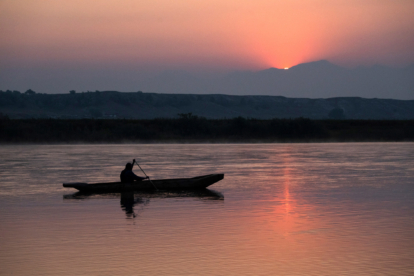Return from That Other Place
Paddling Salish and Nimiipuu home waters, once again.
All photos by Ben Herndon
The 19-foot cedar dugout nosed into Montana’s lower Flathead River. Out of the water for months, the timber had dried and stretched, leaving new paths for the river to enter. The canoe, named Little Martin, was completed in the summer of 2019. It is the first Salish and Pend d’Oreille (Qlispé) dugout made on the Flathead Indian Reservation in 100 years, joining a resurgence of traditional canoe building by tribes all over the Pacific and Inland Northwest.
“We have veins running through each of us,” said Gary Woodcock, a Salish Flathead member of the Confederated Salish and Kootenai Tribes (CSKT). At 63, Woodcock, or čeɫlspuwa (“three woodcocks” in Salish), is lean with a kind face and a single black-grey braid down to his shoulders. He grew up not far from the banks of the lower Flathead. “This river is our vein—the water, our lifeblood.”
“The waterway is everything to us. It’s our origin. Everything happened in these canoes. It’s more than just a dugout. It’s our first vehicle. These have been around longer than the horses have. ”
Nearby, Gary Dorr, or Ha haac’ Ilp ilp wise’ekey’x (“Standing Red Bear”), lit a long traditional pipe and sang a prayer in Nimipuutímt (the Nimiipuu language) for the river and the two-day journey ahead, now slightly delayed as the freshly applied, marine-grade sealant dried on our canoes. Two meticulously woven, jet-black braids tucked behind his ears were accented by pronounced cheekbones and a pompadour style once commonly worn by his ancestors.
The synthetic, snow-white sealant contrasted strangely with the dugout’s natural wood grain. “We have adapted to the modern [times],” Dorr told me after the smoke had settled. “I wear modern clothes. We have full-time jobs and part-time cultures. We need full-time cultures. We are returning to that, but we can’t do that without the land and water.”
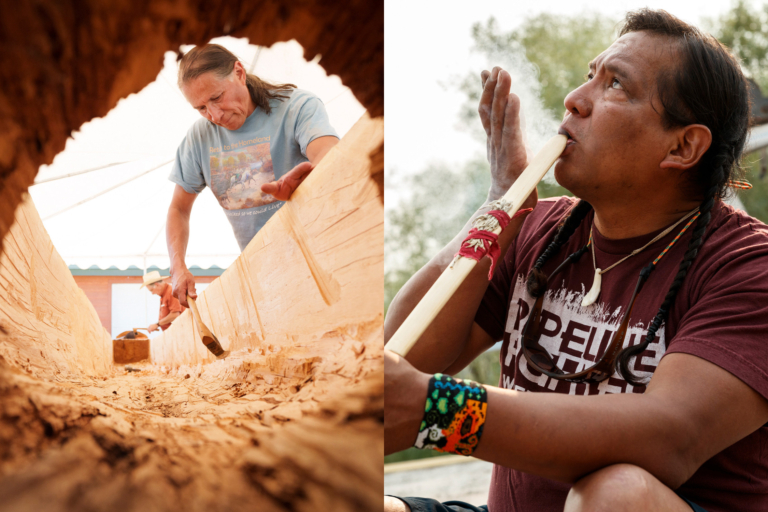
Left: Using an adze and elbow grease, Woodcock begins to liberate the 37-foot dugout canoe from what was a cedar trunk.
Right: Gary Dorr begins his lower Flathead River journey with a prayer.
Though they had different languages and cultures, the Nimiipuu and Salish Flathead were neighbors and traditionally on friendly terms, often visiting, trading and intermarrying. Dorr is a non-treaty Nimiipuu (Nez Perce). They were called non-treaty Nez Perce because they refused to sign the Treaty of 1863 that would shrink their reservation lands by 90 percent from the original Treaty of 1855. US officials pushed for a second treaty after gold was found on reservation lands. The resulting conflicts with homesteaders and unruly miners became the flash point for violence and what would later become The Flight of the Nez Perce in 1877. The non-treaty Nez Perce (and a group of warriors from the nearby Palouse tribe) outmaneuvered and outfought US military forces and volunteer militias through four major battles over four months as they fled from North Idaho to Western Montana. Cold, scattered and exhausted, they eventually surrendered just 40 miles from the Canadian border after a multiday battle near Bears Paw Mountains in Northern Montana. “They call it a war, but it wasn’t a war. It was a flight,” said Dorr, an 11-year US Army veteran. “We just wanted peace.”
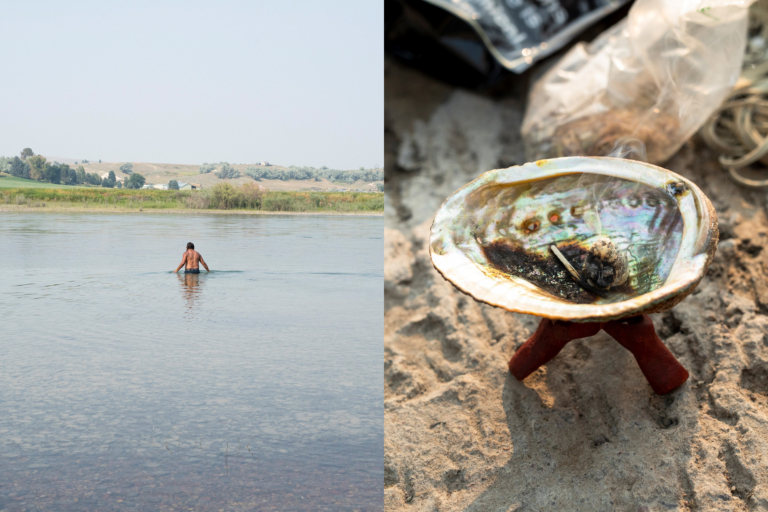
Left: Dorr cools off in the lower Flathead River.
Right: A small bundle of dried sage smolders, creating scented smoke for prayer.
Blue smoke hung in the cool morning air. Stephen Hunt, or Piitaah Pootoowaah (“Eagle Flying Above”), passed around a shell holding a smoldering bundle of dried sage ready for smudging, the process of wafting smoke over your body to cover yourself with protection and gratitude.
Upriver from our put-in loomed the Seli’š Ksanka Qlispe’ Dam (formerly the Kerr Dam). Completed in 1938 against the will of tribal leaders, the dam impedes the southwest drainage of the sprawling 197-square-mile Flathead Lake, one of the largest lakes in the West and a remnant of post-ice age floods. The dam’s construction was a boon for jobs in the Depression Era. Still, some tribal members resisted its creation on what is considered sacred land, a series of roaring cascades known as es t̓ipmétkʷ in Salish, “The Place of Falling Waters.”
The lake and the river have changed substantially in the last 100 years. “As a child, we used to go to the lake, and you could fill a bucket with native trout,” Woodcock said. “That no longer exists. The whole population of native trout has been decimated.”
Biologists think around 10 species of native fish lived in Flathead Lake in the early 1800s. Mackinaw lake trout from the Great Lakes were introduced in the early 1900s, resulting in a massive decline in native species like cutthroat and bull. The clarity of the lake and river has changed, too. “We never used to see that kind of silt,” Woodcock said. “You don’t drink out of the lake or river anymore.”
Efforts are underway to restore habitat and recover native fish populations, primarily funded by a $1.9 billion federal settlement over treaty water rights in 2020. The dam was purchased by the CSKT in September 2015. Though the tribe now has autonomy, it also has the demanding responsibility of balancing the economy with the river’s health—and the dam is the primary source of power for Montana’s entire Mission Valley.
“The question remains—is this dam inherently destructive [to] native cultures? Or can the tribes use it to regenerate a way of life it helped destroy?” asked director Roy Bigcrane in the 1990 documentary, The Place of the Falling Waters.
They’ve proven they can. In 2021, the CSKT Tribal Council passed the Cultural Waterways Ordinance (CWO). This landmark piece of tribal legislation allows for the designation of culturally significant waterways and the implementation of strict, long-lasting protections like those in the Wild and Scenic Rivers Act. The first designated Cultural Waterway? The lower Flathead River.
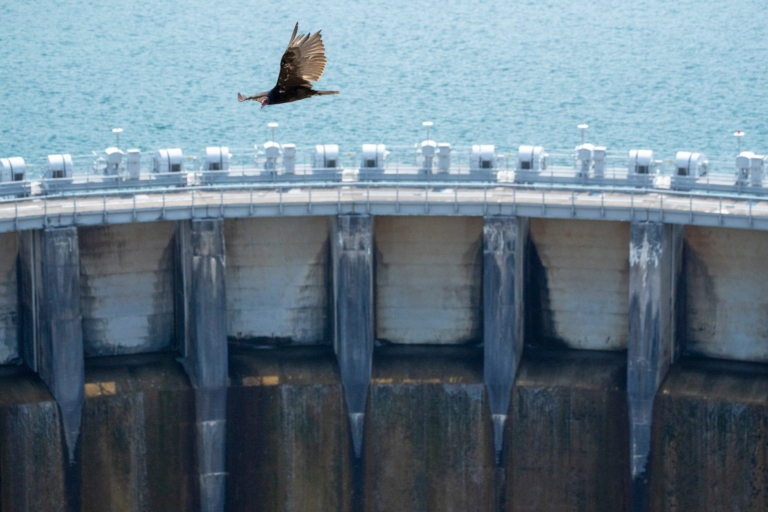
A turkey vulture glides above the towering walls of the Seli’š Ksanka Qlispe’ Dam at the southwest corner of Flathead Lake in Montana, the largest freshwater lake in the Western United States.
After a couple hours of smooth paddling downriver, Hunt yarded a northern pike out of the river. “This fish shouldn’t be able to live here,” he said. Hunt is Blackfeet (Amskapi Piikani), non-treaty Nez Perce (Nimiipuu), Sioux (Sisseton), Pend d’Oreille (Ql’ispé) and Chippewa Cree (Nêhiyawak) but was raised on the Flathead Reservation. Twenty-pound bull trout once prowled waters tinged emerald green from distant glaciers, but the area is now home to largemouth bass, northern pike, brown trout and smaller rainbows.
Hunt fileted the pike as Dylan, his stubby-legged red heeler (who’d be sprayed in “cologne du skunk” later that night), looked on longingly. “I’ve been on this river my whole life and have never seen so many people here,” Hunt said. Across the river sat our intended campsite, a normally quiet, Ponderosa-pine-dotted bend paraded with UTVs (multi-seat off-road vehicles) and diesel trucks. It was a place where Woodcock’s uncle used to find solace and camp when he was young. Recreation numbers are up all over the West, but it hits harder on reservations where so much has already been taken.
A mile downriver, a cobbly, empty bar beckoned. The sun sagged westward as Hunt returned with a handful of wild mint growing along the riverbank. It was soon steeped into a delicious, sweet tea, the leaf oils shimmering on the surface. “When we spend time in the environment, we read it like a book,” he said, a fog of mosquitoes humming about his shoulders. “That’s the big difference between our culture and Western culture. Each place is a story.”
Dorr and Woodcock canvassed the nearby tribal forests for pine resin in an eerie light the next morning, the sunlight a saturated yellow from forest-fire smoke. Hunt had badgered us to get an early start to beat afternoon winds, but as the dugout slid in the water, the river flowed in through new cracks that had formed overnight. The harvested pitch bubbled as it melted under the heat of a Jetboil. Woodcock poured the amber-hued liquid into the cracks using a flat rock as Dorr scraped in remnants with the edge of a knife before the pitch cooled.
The pine resin repairs held, but our paddle strokes became labored at noon. Westerly winds swept across the water. The gusts transformed the canoes into sails, stopping downriver progress and making steering near impossible. Hesitant to surrender to modern-day conveniences, our crew reluctantly caved and fixed tow lines to Hunt’s motorboat for the final few miles. The magic of an ancient human-powered mode of transportation was somewhat diminished by the lug of the two-stroke Johnson engine. “Everything’s on a tight schedule now,” said Woodcock at the take-out. “We don’t always have extra days just to pull the canoe over and wait out the wind like our ancestors. So, it’s a mix of old school and new school.” Nearby, large diesel fire-fighting trucks lumbered in and out, refilling with river water before heading back into the hazy hills.
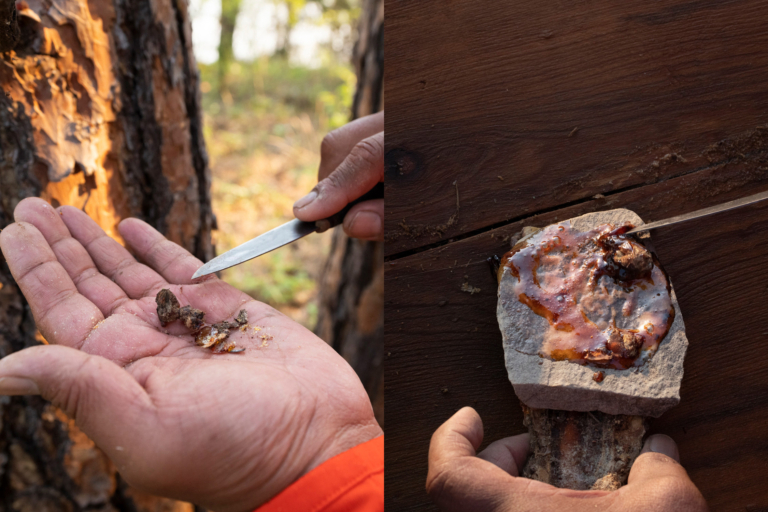
Left: Pine resin, a traditional material for repairing leaks and cracked or seeping wood, was collected along the journey to repair the dugouts.
Right: After harvesting, pine resin is heated until it melts into a malleable liquid.
A month later, our trucks traced a narrow gravel road along Idaho’s Selway River. It was a quick stop en route to floating a portion of the Lower Snake River in southeastern Washington State. Both waterways, the first—free-flowing—and the second—tamed and slack—are part of Dorr and Hunt’s Nimiipuu home waters. We crossed a small bridge over Gedney Creek and passed a heavily occupied campsite with a large, portable flagpole. A “Don’t Tread on Me” flag presided over ground that was within reservation lands designated in the 1855 treaty and was very likely a camping/fishing spot of the Nimiipuu for thousands of years. In 2019, just 53 miles to the west, archeologists found plentiful evidence of human occupation going back 16,000 years. “It wasn’t an accident,” Dorr said. “Our creation story puts us here.”
The runoff starved Selway Falls flowed so low that the polished hues of typically modest, submerged granite displayed dry, naked rock patterns. Woodcock plopped into a perfectly human-sized pothole on a bleach-white boulder shaped by millennia of fluid hydraulics. He jokingly tossed a Parachute Adams into a calm pool behind the boulder and was surprised to get a couple good grabs before he figured out that the hook was broken.
Dorr and Woodcock were adopted into non-native homes at a young age. Woodcock was adopted (along with his older brother) at age 3 by my grandparents. “When I first got there, she (my mom) would just hold me and tell me, ‘You are loved. You are special.’ That made the biggest imprint on me,” he said. “But I was a native kid on the rez, never exposed to my culture. I knew I was different than my family.”
As a young adult, he began reconnecting with his biological family and community. “I realized I wanted to do something for tribal people, specifically children.” Some 40 percent of the roughly 4,000 foster children in Montana are Indigenous, even though Natives make up less than 6 percent of the state’s population. In 2019, Woodcock, Hunt and other tribal members started Snqʷeyɫmistn (Salish for “the place where you do your best”) to “provide culturally relevant homes for foster children on the Flathead Reservation and nurture Indigenous community through experiential learning and traditional lifeways.”
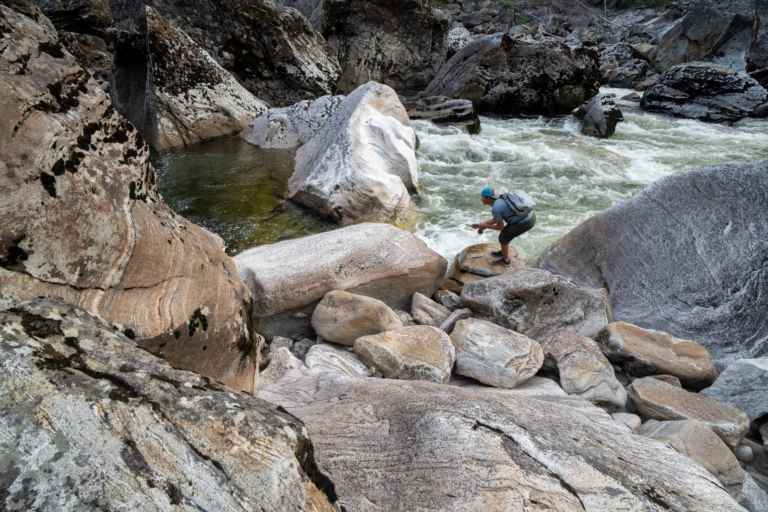
Woodcock investigates a trouty-looking bucket on Idaho’s Selway River.
Two invasive-species inspectors in orange vests walked laps around the trailered dugout at a boat inspection station just outside of Kamiah, Idaho. Grey-haired and friendly, they seemed confused about how to categorize the watercraft on their forms. Before they could even ask about it, a chest-puffed Standing Red Bear (Dorr) set on them like his namesake, delivering a robust explanation of treaty rights. They quickly retreated after giving the craft an expedited look over, not ones for poking bears.
In Kamiah, we stopped at timʼné•pe, the “Heart of the Monster,” a sacred 20-foot basalt mound in a fenced grassy field off Highway 12. It’s the source of the Nimiipuu creation story and the birthplace of “the people” (the English translation of “Nimiipuu”).
Dorr shared the Nimiipuu origin story with us—that before there were people, a giant monster had swallowed all the animals. Coyote (It’se-ye-ye) heard of this and tricked the beast into inhaling him. Once inside, he killed the monster, freeing all the other animals inside. He then spread the monster’s organs to different places throughout the land, each one creating a different tribe.
Dorr said that the proximity of the Nimiipuu birthplace to the river was not by chance. “The waterway is everything to us,” he said, gesturing to the Clearwater River 180 yards behind us. “It’s our origin. Everything happened in these canoes.” He passed out cigarettes, and we’d later crumble the tips for a tobacco prayer at the foot of the Heart. “It’s more than just a dugout. It’s our first vehicle. These have been around longer than the horses have.”
When I asked why he worked on Indigenous boat projects and education with elementary classes consisting of mostly white children, he replied, “Who needs to hear it more? [Native] kids who hear the stories every week from their Elders or these kids who know so little of the real history of where they live?”
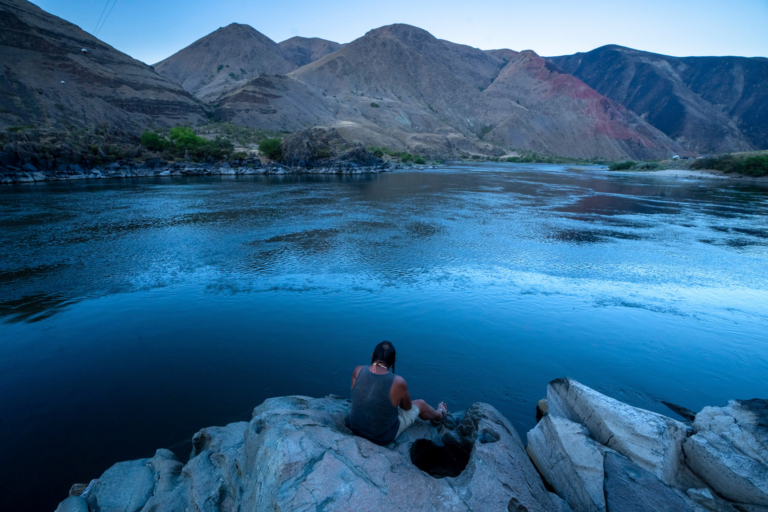
Dorr sings a prayer at a sacred ancestral site along the Lower Snake River. Washington.
The sun was slipping behind the steep canyon walls as we arrived at the Snake River. Sunburned beachgoers packed up in the dusky light. Above, blackened hillsides contrasted with the brick-red fire retardant. Signs warned visitors: “Dangerous undertow—swimmers have drowned here”—at least six in the last eight years.
The power of this place reverberated beyond the dangerous, churning eddies. Ancient art is everywhere. Bighorn sheep, elk, snakes and human figures, some more than 3,500 years old, are all etched in the glazed basalt. This has been a place of gathering and prayer for hundreds of generations of Nimiipuu.
To most, the valley appears nearly as it was millennia ago. But, beyond the obvious road cuts and occasional riverside homes, the changes are more subtle. Whether it’s decades-old rusted barbed wire or barbed yellow star thistle, invasives come in many forms. Scars on the rock show where vandals attempted to chip out petroglyphs.
Dorr sang a prayer in Nimipuutímt over deep, swirling currents—a series of haunting hey yaw, hey yaws that changed the canyon, transporting the landscape into a time when only Nimiipuu voices echoed off the basalt walls. The prayer had barely faded when a succession of three jet boats severed the bend in time and shook us back into the present. Sound is a wild sense, invoking memories one moment and shattering them the next.
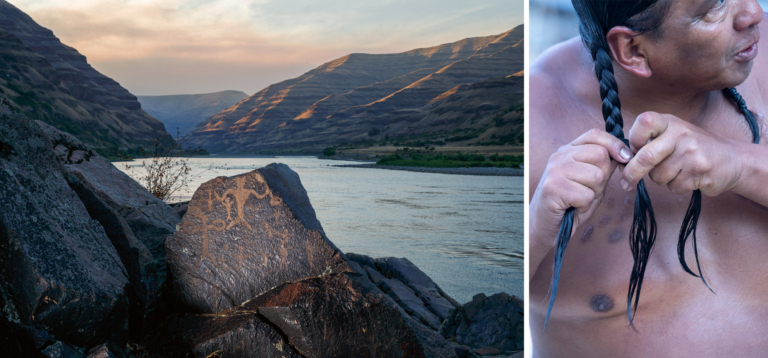
Left: Petroglyphs ranging in age from a few hundred up to 6,000 years old still silently guard the Snake River.
Right: Ahead of a long day paddling, Dorr practices some braid maintenance.
Approaching the Snake River’s Lower Granite Dam, “lock” seems an inconspicuous word for an 86-by-674 foot wide, 140-foot-high concrete corridor capable of holding a 4-story tugboat and four 200-foot grain barges. It acts as a massive elevator and can be filled with (or drained of) 46 million gallons of water to raise or lower river traffic (primarily commercial grain shipping) up to 105 feet. It likely feels big from the perspective of a barge, but it feels massive sitting in a dugout canoe.
The Lower Granite Reservoir was punctuated with whitecaps the next day, and the canoes struggled against a gusting headwind. Another unromantic tow from a motor brought the boats to Lower Granite Dam just in time for the 12:30 p.m. lock.
“There aren’t going to be any problems, are there?” the lock operator asked me as Dorr, Woodcock and Hunt paddled ahead out of earshot and into the filled lock. “We’ve had problems before.” His next words were cut short by a loud, defiant whoop by Dorr in the distance, unaware of the conversation but giving the perfect reply.
“In just 100 years, we’ve gotten to where now we can have only a palm-full of salmon for the whole week,” said Hunt, as the water level dropped in the locks and the bright midday light grew dim. “How can you tell that to an Elder that once lived off it for every meal? We’re not being crazy Indians. We’re not here for ourselves. We’re doing it for those who can’t speak—the future generations, our children.”
“It felt like you could just be swallowed up,” Woodcock said of paddling out of the “concrete canyon” after the 20-minute draining was complete. The towering gates slowly shifted to the sides like enormous steel curtains.
“In a day, we have traveled from the Heart of the Monster to the belly of the beast,” Dorr said at the take-out three-quarters of a mile downriver. “When I was praying to those ancestors,” he said, recalling a multiday vision quest atop the Heart many years ago, “that was my prayer that came to me: to return, to come back from that other place. Hipaayksa, Hipaayksa, Hipaayksa. Return from that other place.” After a pause, he added, “Who am I, though? I was adopted out. I’m nobody.” Then he was told by a tribal member, “You went away, but you came back. That’s not by accident.” Hipaayksa. Return from that other place. Behind him, a tug doggedly pushed empty barges upriver toward the open lock.
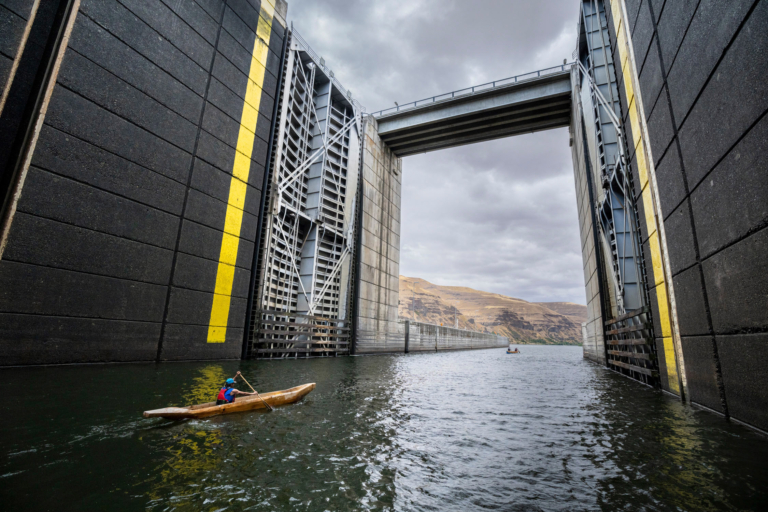
Woodcock navigates the locks at the Snake River’s Lower Granite Dam in his Salish Flathead dugout canoe.
